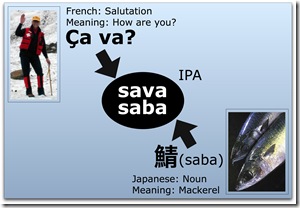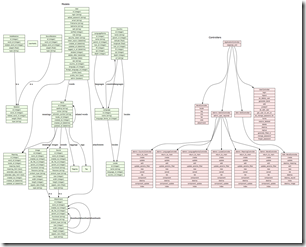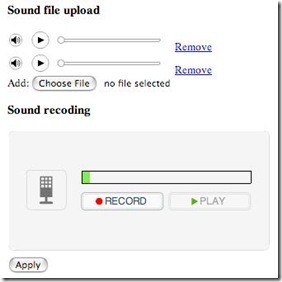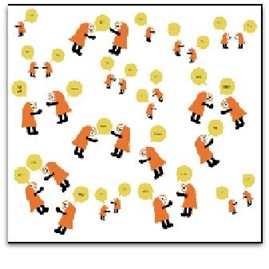By TAKUMI ENDO
Project Phonethica is an interdisciplinary art project, which explores the world through the phonetics of language. Combining scientific technology with art, Project Phonethica maps out the diversity and similarity of the worlds 6,000 existing languages. Project Phonethica aims at developing a practical strategy for vigorous survival in the post-modernized society, which has been openly enjoying chaos as a conclusion of its own fragmentation.
INTRODUCTION
Project Phonethica began in Tokyo and Paris in 2004, aiming to collect fundamental data through a wide range of interviews with for example: artists, scientists, composers, linguists, phoneticians, anthropologists, philosophers, and sociologists. During this period of time, research has also been undertaken in order to develop Phonethica System – a computer system based on the phonetic feature of language
 The project will be disseminated to the public in the form of online tools, interactive installations and other media in all over the world from 2007.
The project will be disseminated to the public in the form of online tools, interactive installations and other media in all over the world from 2007.
MISSION
As you may know that the word, ”Serendipity”, which you can see in the subtitle originally came from a folktale describing a “journey” of a prince, human beings leave behind the Known when they journey away from home. At one time, travel signified a rite of passage, a chance to feel truly alone, insecure and at odds with the World. The discomfort and insecurity it created had a singular impact on us, and the friction caused by for instance, a change in temperature or an alien smell or taste, could bring about a deeper recognition of one’s Self. Our very skin signifies a border – the place where our body ends and the outside world begins. Developments in transportation, improvements in communications, and the onset of globalization have meant that opportunities for this type of travel grow ever rarer in a seemingly shrinking world, The Project has become more mobile and more canny about the World’s countries and cultures.
Project Phonethica represents the possibility of creating an alternative or counter value system in a world, which has become overtly structured and entrenched with fixed systems of meaning.
Taking the diversity of mankind as its starting point, it attempts to make a new kind of reference tool, one governed more by chance more than by reason.
Project Phonethica does not aim to protect languages or archive them in libraries. Rather, it endeavors to invent a dynamic method by which we can understand and appreciate our diversity and randomly disseminate it as part of a wider social movement.
BACKGROUND
At present, there exist in our world at least 5,000 languages, some say as many as 6,000. In 1992, American linguist Michael Krauss presented a shocking report stating that fifty to ninety percent of the languages in the world will be wiped out within the next century. Moreover, according to a report based on a UNESCO – sponsored international conference on endangered languages that took place in Thailand in 2003, roughly 3,000 languages, half of all those currently in existence, are no longer taught in elementary schools, and are already on the brink of extinction. The report further warns that forty percent of the world’s languages, approximately 2,400, will cease to exist beyond our children’s generation.
Our language is thus in a state of crisis. The predicament can also be regarded as a threat to our very diversity.
At first sight, the integration of our languages does not appear as an entirely negative trend. It can ease tensions between tribes, for instance, and may be beneficial to our global economy. History has frequently witnessed members of a minority community discarding their own language in favor of that of the mainstream in an attempt to enhance their socio-economic status, while, of course, there are also countless examples of larger communities forcing adherence upon minority groups.
But even when we take into account the positive effects of language integration, the number of people concerned over the disappearance of the world’s languages is far from few, and its implications are understood to be far-reaching. In particular, there are strong implications which are of a scientific and scholarly interest. Many of the fundamental issues addressed by language research are linked with the enigma of our mental structure, that is to say by the challenges presented to us in the study of the structure and conventions of human language. Thus far, we could hardly claim that this enigma has been solved. The more languages we can examine in the course of this scholarly research the better.
Conversely though, we can also regard the sense of loss brought about by the death of the World’s languages as a product of Mankind’s collective ego. We perceive something positive in our own diversity because we believe it innately desirous for the thriving of our species. Had we not diverged to the extent that we have, and if we were nothing more than facsimiles of one another, we would simply have become extinct at the hands of a single disease or one episode of climatic change. If we regard this phenomenon of diversity merely as a means to avert a catastrophic situation, then the fact that we assign some cherished worth to our diversity can be reasonably explained in saying that diversity secures our prosperity.
If the loss of minor languages is considered to be a conversion in favor of the major language, so people feel a sense of resentment with regards to the homogenizing effect of globalization. Moreover, this sort of negative mindset is transformed into a kind of fulfillment when shared with others, and in time, the world could be engulfed by apathy.
PHONETHICA WEB
The Phonethica Web can find words from among the world’s different languages that sound similar to a given word. For example, while Japanese and French are vastly different languages, the French expression “Ça va?” meaning, “How are you?” and the Japanese word for mackerel, “saba,” actually sound quite similar
 In fact, because the structure of human vocal organs varies little from Japanese to French to Kenyan, these types of coincidentally shared sounds occur often. Anyone who speaks more than two languages is probably aware of a few examples of this. And sometimes one finds humor in the extreme disparity in meaning held by words which sound similar. The Phonethica Web can find such words and relationships from among the world’s different languages, by comparing their sounds.
In fact, because the structure of human vocal organs varies little from Japanese to French to Kenyan, these types of coincidentally shared sounds occur often. Anyone who speaks more than two languages is probably aware of a few examples of this. And sometimes one finds humor in the extreme disparity in meaning held by words which sound similar. The Phonethica Web can find such words and relationships from among the world’s different languages, by comparing their sounds.
In addition, The Project aims to implement a new feature that accesses with texts of all ages and countries containing the words, which are found by Phonethica System and used as pivot words in this proposal. For example, existing systems have an ability to find and distinguish between words that have sounds phonetically close, such as “bug” in English (means “insect”) and “bug” in Russian (means “god”). The Project intends to expand it and create the system through Web technology that presents all the texts containing “bug” in Russian from Russian Christianity’s Bible to descriptions of gods of indigenous belief in tundra regions.
Using the Phonethica Web, people can dynamically access information related to the specified languages. Such information includes: descriptions explaining the culture, native speakers, environments in which they live, types of food they eat, kinds of songs they sing, history, religion, economic and political situations. Information on grammar, vocabulary, orthography, phonology, writing and numbering systems also will be available.
In this way, facts unknown to us come within our reach, not based on the matching of definitions for different words that we can usually locate in a dictionary, but through words that are phonetically similar by chance.
For instance, you may be inspired to learn about the lives of the Taba-speaking inhabitants of the Molucca region of Indonesia, which you never even knew existed. And the next day, you may want to tell your friends about your discoveries. And if you find the salutations and customs of that region particularly interesting, you and your circle of friends might want to adopt them into your own interactions and create a trend. Eventually someone in the group might be roused to visit that place. And, perhaps even years or decades later, that person may decide to take the plunge and travel there. If we live in a world where one can be provoked by such coincidence, then we can imagine the potential that may still lie therein.
If, in this way, two symbols which previously appeared as unrelated can become connected through their very sound, then this common denominator can create a valuable new interface which potentially could relate all aspects of the Earth to each other. This interface will at first promote an awareness of our diversity which will then, paradoxically, give rise to a quiet consciousness of our being related respectively to one another. The world will secretly but certainly grow conscious of its connectedness and its universality.
HOW IT WORKS
Phonethica Web consists of three elements as follows;
1. Phonethica DB – The World Language Database
Phonethica DB has been developed using MacOS, Ruby on Rails and MySQL.
2. Phonethica Process – The Word Comparison System.
Phonethica Process has been developed using MacOS, MATLAB, NYM Library, Nellymoser, Moyea FLV to Video Converter and UWSC.
3. Phonethica Viewer – Interface. Phonethica Viewer has been developed using MacOS and Flash.
CELL NETWORK The words selected by the user inter-linked with similar words to form networks.
Each word is displayed as a cell that hovers on the screen. The cells shift their position dynamically and seamlessly according to their relationship with one another. The user can navigate smoothly between the networks of phonetically similar words by clicking. In addition, images in the cell are gathered from Flicker by tags of the word.
The user can thus understand the word meaning, through both text and image alike.
VOICE AND TEXT UPLOADER The user can submit his own words both by writing text and recording voice, including related information such as meaning, tags, phonetic symbols and so on and so forth
In this way, The Phonethica DB will be widely expanded. The project expects to receive many thousands of new words, especially from native speakers on minority language groups, as well as linguistic researchers concerned with endangered languages.
PHONETHICA VOTE Phonethica Vote (see Figure 8) allowing users to vote and rank word relationships. For instance, if a visitor to the site feels that the relationship between the words ‘cava’ and ’saba’ is quite close, he/she can vote to rank this relationship higher. Similarly if another visitor feels these words are not so similar, he/she can also vote against them to lower the rank. The Phonethica Process will therefore quickly become more and more reliable.
PHONETY “Phonety” – a virtual pet game which will provide a new paradigm for acquiring knowledge through the Internet community.
“Phonety” is envisaged as a front-end application for compiling a globally based language database for “Project Phonethica,” The immediate mission is to have “Phonety” incorporated in the project “OLPC – One Laptop Per Child” which Prof. Nicholas Negroponte, Director of the Media Laboratory at MIT, is promoting.
SUMMARY
Phonety, the main character in the game, Phonety, is a virtual pet which grows by eating words. Just like a human baby, Phonety learns words and starts communicating with the game player using the acquired vocabulary
Phonety often learns foreign words by communicating with other Phoneties raised by other players and picks up bits of information from news and blogs, etc. on the Internet by using the newly learned words as keywords. Phonety can also do other things like composing haiku using the newly learned words and singing hip-hop by matching rhyming words.
Words, which Phonety has learned, are periodically stored in the Project Phonethica’s web server using a method programmed as a natural habit of the pet.
By playing this game, people around the world will help contribute to the conservation and development of human cultural diversity centered on languages.
Phonety will first be developed as software for Mac/Linux/PC, and then will be transplanted to other media such as cell phones, Sony PS3/PSP, and Nintendo Wii/DS one after another.
The reason that virtual pet games, such as TAMAGOTCHI, which became a big hit worldwide, are able on occasion to capture the keen interest of consumers is because the interaction is based on a clear relationship, “paying attention to and receiving attention from,” between a player and a virtual pet. Phonety aims to create a global language database by utilizing the relationship of a player and a pet in the virtual pet game for data mining on a mass global scale, something which has been very difficult to do using conventional methods.
BASIC SCENARIO Players start the game by giving a name to a newborn Phonety. Players feed Phonety words via a microphone little by little everyday just as they give food to their actual pets. Phonety gradually grows up by eating the proffered words and starts communicating with the player using the words which Phonety has learned. Phonety gradually develops its vocabulary, understanding the concept of a given word by solving binary-tree structured quizzes (e.g.,20 Questions) together with the player.
As the spontaneity of Phonety improves with the development of its vocabulary, Phonety actively starts establishing relationships through the Internet with other Phoneties raised by other players.
Phonety then starts exchanging vocabulary with other Phoneties around the world.
Moreover, Phonety starts making sentences using the new words and tries to communicate with the player using the sentences, much as a human kindergarten pupil tells their mother all about their day. In addition to teaching Phonety new words, the player can learn completely unfamiliar words (possibly from foreign languages) through this communication with Phonety. Using words, which Phonety has learned, Phonety also finds news and blogs on the Internet and composes funny poems, haikus or tankas (thirty-one syllable verses). When Phonety’s vocabulary is highly developed, it will start verse linking with the player and other Phoneties. As well, Phonety sings its original hip-hop songs by matching rhyming words. The player can use such songs as ring-tones for their cell phone or can post them on the Internet community sites for A players. Moreover, Phonety may fall in love with other Phoneties raised by other players, and sometimes even marry and have children.
The words, which Phoneties have learned while quickly and healthily growing under the care of players all over the world, are sent to Project Phonethica’s web server through various events programmed in the game. The words registered in the web server are tagged by players who visit the site one after another with language names, meanings, usages, pronunciation symbols, audio-based information, etc. and are stored in the “Phonethica DB.”
THE VALUE OF SPOKEN LANGUAGES IN THE PROJECT
According to Hakutarou Jouo, a linguist, a language can be defined as below.
: Every language in this world has sounds.
: Every spoken language in this world has vowels, consonants, syllables, intonations, pauses, and accents.
: Every language in this world has a grammar.
Nations who does not have their characters exist but there is no nation without spoken language. Once a person is born as a human under the sun, naturally he can speak unless he suffers serious impairment. According to Noam Chomsky, a linguist, that speech language is an innate ability but people must purposefully work with read and write to master it. As you can see from this, speech language is one of the universal facts. Therefore, treating speech language as pivot is a very rational choice for establishing the purpose of this project “the system for seeking the world”. However, thinking more ideally, it can be seen that a language has the feature flicking something that cannot be verbalized out of it. Thus, people continuing to remarkably extend the language activities became not to cognize some phenomenon that cannot be verbalized. This project will achieve the mechanism to ensure a variety of phenomenon in the world in which an access code is left lost, performing the dynamic information representation by combining scientific technologies and the magic of arts.
OUTLOOK This project advocates a new architecture for accumulation of information between the Internet community and the real world. It will be realized by the organic cooperation between the front-end application that arouses the curiosity of the public and the Phonethica Web as a hub for global information. Since then, autonomously operating, it will create new research areas at various levels.
The achievement for this project will be also useful as the resource to educate people who have an international perspective. In general, people who don’t doubt their own identities such as nationality, status and sexuality are insensitive to others, so they can’t develop substantial thought about what is going on in the world. From now on, having the ability to look at world events from a multilateral and comprehensive viewpoint should be indispensable to global citizens. The dynamic and diverse experience by Phonethica system will dramatically enhance such ability.
By aggregating massive language data, which was collected from users all over the world and front-end application with seamless materialized this system. The system functions as “Global language / Cultural information hub” hereafter. Also it does contribute conservation and continued development of cultural diversity of the human being by alleviating the speed of current language death. (For your reference “One word per fortnight” – UNESCO. 2003).
CONCLUSION
Project Phonethica represents the possibility of creating an alternative or counter value system in a world, which has become overtly structured and entrenched with fixed systems of meaning.
Taking the diversity of mankind as its starting point, it attempts to make a new kind of reference tool, one governed more by chance more than by reason.
Project Phonethica does not aim to protect languages or archive them in libraries. Rather, it endeavors to invent a dynamic method by which we can understand and appreciate our diversity and randomly disseminate it as part of a wider social movement.
References:
Chomsky Noam. (2002). Syntactic Structures. Walter De Gruyter Inc.
Crystal David. (1997).The Cambridge Encyclopedia of Language. Cambridge University Press.
Dawkins Richard. (1990). The Selfish Gene. Oxford University Press.
Derrida, Jacques. (2004). Counterpath. California: Stanford University Pres.
Flickr. http://www.flickr.com
FLV to Video Converter. (2006). www.flash-video-mx.com/flv_to_video_web
Jouo Hakutarou. (1990). Gengogaku wa kagaku de aru. Joho Center Publishing CO.,Ltd.
International Phonetic Association. (1999). A Guide to the Use of the International Phonetic Alphabet. Cambridge: Cambridge University Press.
Krauss, Michael. (1992). The world’s languages in crisis. Language 68/1:4-10.
MATLAB. (2006). http://www.mathworks.com
MYM Library. (2006). www.epfl.ch/software.php
Nellymoser. (2006). www.nellymoser.com
Science. (February 2004). Evolution of Language.
Shaeffer, Sheldon. (2003). Language Development and Language Revitalisation:An Educational Imperative in Asia. Conference on Language Development, Language Revitalization, and Multilingual Education in Minority Communities in Asia November 6-8, 2003, Bangkok, Thailand.
UWSC. (2006). http:// www.h7.dion.ne.jp/~umiumi
Wayt Gibbs. (2003). Saving Dying Languages. Scientific American. pp. 80.







Your blog is so informative … ..I just bookmarked you….keep up the good work!!!!
Hey, I found your blog in a new directory of blogs. I dont know how your blog came up, must have been a typo, anyway cool blog, I bookmarked you. 🙂
–Robert Shumake Fifth Third